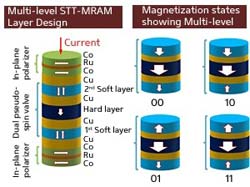Data storage: Magnetic memories

Enhanced magnetic storage devices. An electrical current passing through a stack of magnetic layers (left) is used to write and read magnetic information. The relative orientation of the soft magnetic layers encodes up to four bits (right).<br>
Solid-state memory is seeing an increase in demand due to the emergence of portable devices such as tablet computers and smart phones. Spin-transfer torque magnetoresistive random-access memory (STT-MRAM) is a new type of solid-state memory that uses electrical currents to read and write data that are stored on magnetic moment of electrons. Rachid Sbiaa and co-workers at the A*STAR Data Storage Institute1 have now enhanced the storage density of STT-MRAM by packing multiple bits of information into each of its memory cells.
“As a technology, STT-MRAM has several advantages,” says Sbiaa. “They have high read and write speed, low power consumption, great endurance, and are easy to integrate with standard semiconductor-processing technologies.” Further increasing the storage density remains a challenge, however, because the write current needs to be increased to keep the bit thermally stable. A solution to overcome this problem is to use memory cells that can hold multiple bits, but scientists have yet to achieve the electrical control needed for this kind of STT-MRAM.
Essentially, STT-MRAM reads and writes information by passing currents through multiple magnetic thin films. Information is written if the magnetic moment of electrons in the current, or spin, is aligned in one preferable direction. The torque by these aligned spins on the magnetic layers can be strong enough to switch the magnetic direction of the layers to the direction set by the current.
Reading information is done through the measurement of electrical resistance of the device, which depends on whether the magnetizations of the soft and hard magnetic layers are aligned in parallel or opposite directions relative to each other. The hard magnetic layer is designed in such a way that its magnetism cannot be switched by electric currents.
To store two bits, the researchers have now added a second soft magnetic layer. These two soft magnets are slightly different, one being ‘harder’ than the other, and can therefore be switched independently by a suitable choice of electrical current. In this way four possible combinations for the magnetic states can be addressed by electrical currents, corresponding to two bits of information (see image).
Furthermore, the researchers introduced magnetic layers polarized in the in-plane direction that enhance the torque effect and thereby reduce the overall electrical current required to write information.
In the future, the researchers plan to use a different device design based on electrons ‘tunnelling’ across an insulating layer. “These magnetic tunnel junctions provide a higher read signal than for a giant magnetoresistance-type device,” says Sbiaa.
The A*STAR-affiliated researchers contributing to this research are from the Data Storage Institute
Media Contact
All latest news from the category: Physics and Astronomy
This area deals with the fundamental laws and building blocks of nature and how they interact, the properties and the behavior of matter, and research into space and time and their structures.
innovations-report provides in-depth reports and articles on subjects such as astrophysics, laser technologies, nuclear, quantum, particle and solid-state physics, nanotechnologies, planetary research and findings (Mars, Venus) and developments related to the Hubble Telescope.
Newest articles

Silicon Carbide Innovation Alliance to drive industrial-scale semiconductor work
Known for its ability to withstand extreme environments and high voltages, silicon carbide (SiC) is a semiconducting material made up of silicon and carbon atoms arranged into crystals that is…

New SPECT/CT technique shows impressive biomarker identification
…offers increased access for prostate cancer patients. A novel SPECT/CT acquisition method can accurately detect radiopharmaceutical biodistribution in a convenient manner for prostate cancer patients, opening the door for more…

How 3D printers can give robots a soft touch
Soft skin coverings and touch sensors have emerged as a promising feature for robots that are both safer and more intuitive for human interaction, but they are expensive and difficult…





















